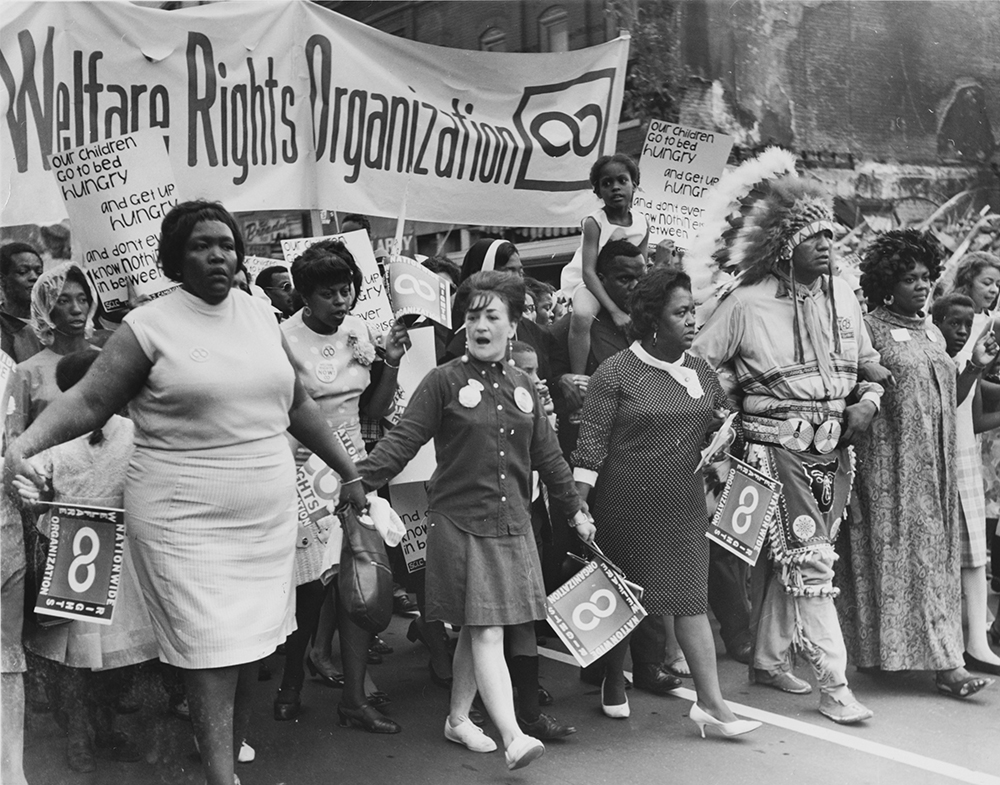Poverty: How Can We End It?
by Jennifer Fisher
Southside Chicago, 10 PM. A 15-year-old Black girl returns to her home in a dilapidated housing project after working all day at a fast food restaurant. Her ten month old baby is waiting for her, because his father, a high-school dropout, never arrived to pick him up. Once inside, she closes the door hoping to block out the sounds and misfortunes of the ghetto, but it is worthless because her life and her surroundings are inseparable–the ghetto has already done its damage. She has tried to make it, but everyone and everything around her are living proof that tell her she cannot. At age 15, the period during which most American girls begin building their dreams, this young Black girl has already given up.
Although merely a scenario, the above sketch is a realistic picture of a member of America’s desperate Black underclass. A world apart from and a world often unrecognized by mainstream America, Blacks in inner-cities and poor neighborhoods all across the country live each day just hoping to survive. Amidst their apparent hopelessness and despair, families and entire communities try to gain the strength to at least deal with the the daily obstacles they will face if they cannot overcome them.
Today, although discrimination and racism are in no way nonexistent, by neglecting our duties to the community, African-Americans and their White counterparts are keeping back an entire class of other African Americans
(9.3 million to be exact) and others as well.
Several factors are often cited as causes for this perpetuation of a class of citizens living in constant poverty. Reasons often cited by civil rights leaders include lingering effects of over 100 years of racism, discrimination and second-class citizenship enforced by legislation and the institutionalized discrimination that did not disappear when the legal barriers to equal opportunity were removed. Other causes include unequal benefits and resources, inadequate educational opportunities and the lack of jobs. More contemporary explanations for poverty point out the disintegration of the Black family which supposedly leads to a loss of traditional moral and family values. The heavy influence of gangs and drugs in these communities where there is an absence of other alternatives and support is also a growing situation blamed for poverty.
During the years since the Civil Rights Movement, there has been a steady increase in middle class Blacks. In general, the number of Blacks in powerful positions has also been on the rise including the appearance of more successful doctors, businessmen, educators, attorneys and politicians. Unfortunately, the rise of the Black bourgeoisie has also been accompanied by an increase in the number of Blacks living in poverty.
In an era where the majority of the legal barriers hampering the progress of Black Americans have been broken down and several federal programs directed at rehabilitating and uplifting the lower class have been established, society is confused. Social scientists, leaders, politicians, Blacks and Whites alike stand baffled at the plight of the Black underclass. Some blame ill-formed and poorly administered government remedies. Others even cite affirmative action programs as encouraging an inferior status for Blacks and causing Blacks not to work hard due to this favored status for color. However, despite finger-pointing, those offering criticism have come short of offering any answers.
As the first step in solving or at least reducing poverty in the U.S., upper and middle class Black Americans must take responsibility. At the foundation of all Black communities past and present is reinvestment. This process of giving back to something that gave you the opportunity, skills and support one needed to succeed is what keeps Black communities strong.
According to an analysis of data from the recent U.S. Census by the Center on Budget and Policy Priorities, the poverty rate of Blacks was triple that of Whites in 1989. Two of every five Black families have incomes that put them in the poorest fifth of American families. Over nine million people or 30.7% of Blacks fell below the poverty line. Even more devastating, one of every two Black children are poor. Last year’s census data also showed that those who are poor are growing poorer. Thirty-eight percent of all poor Blacks have incomes below half the poverty line. Half the poverty line is equivalent to an income of $4,943 for a family of three. Even more depressing, Center Director Robert Greenstein states that “after seven years of (economic) recovery, the nation failed to reduce the poverty rate even to the levels of the most severe recession years of the 1970s. With the economic sluggishness of the early 1990’s, the poverty rate is likely to climb still higher.”
These are the facts; it is obvious that there is a problem, but the even larger problem is the lack of a solution. When there are more Black men imprisoned than there are in institutions of higher learning, and 59% of all poor Blacks live in families headed by a single woman — where do we begin? It is difficult to find a starting point when the problem so severely effects young and old that each age group is in need of immediate attention. As the first step in solving or at least reducing poverty in the U.S., upper and middle class Black Americans must take responsibility. At the foundation of all Black communities past and present is reinvestment. This process of giving back to something that gave you the opportunity, skills and support one needed to succeed is what keeps Black communities strong. Black Americans were unified and proud of their common culture and heritage during the past and this formed a bond because their common color meant common inferiority approved by law. After the Civil Rights Movement and legal barriers were removed, Blacks were still faced with institutionalized discrimination, racial prejudices and stereotypes. Federal fostering tried to remedy the problem and provided affirmative action, benefit programs and constitutionally approved protection. However, Black Americans forgot the one thing that kept them together throughout their struggle. Many of us lost touch with that hidden factor which gave us the will to keep praying, hoping and fighting in the face of persecution. This power that enabled us to succeed when everything and everyone in power was against us was lost in the transition from oppression to freedom. This lost fountain of race empowerment is reinvestment.
Blacks must realize that while America as a democratic society must protect its citizens, we must take direct responsibility. Whether or not the government helps, the situation is too grave to waste time pointing fingers while our brothers and sisters tumble farther down both the economic and social ladders. In order to stop the endless poverty cycle wherein those given inadequate benefits and education grow into inadequate citizens, Blacks must take the initiative in their own communities on behalf of their own. The problem can largely be attributed to the severance of vertical linkages between the upper, middle and lower classes within the African-American community. People tend to form associations and organizations with those from their own economic and social strata. Once Black middle class and elites become established, they are often forced to concentrate on holding their own ground and position. But in order to reduce poverty and hopefully end it, these members of the Black community must take that extra step and lend a helping hand to someone still trying overcome the odds. All of this can come from the reinvestment of time, money, encouragement, support and the simple act of serving as a role model.
Poor Black adults need reassurance, youths require hope and encouragement so they will see that they are not destined to a life of poverty. In inner-city and ghetto schools, Black students often suffer from academic frustration, boredom and eventually failure. With the removal of those who have made it from the community, Black children no longer see any of the benefits of education because dope dealers are the only ones with wealth and authority. There’s a desperate need for Black teachers in Black schools, Black businesses in Black communities and other tangible and visible evidence of legitimate Black success. There is no doubt that the poor need money and continued government support while the community is being rehabilitated by reinvestment and they can stand on their own. More importantly however in ending the poverty cycle, the poor need to see Black faces, as well as Black money.
America’s economic system is not well endowed with the capacity to handle a permanent underclass. In his current book, The Undeserving Poor: From the War on Poverty to the War on Welfare, Michael Katz blames American values for the cultural explanations of poverty. According to Katz, these explanations “failed to challenge the structure of the welfare state.” Middle and upper-class Black Americans must challenge this welfare state and allow those suffering from urban poverty to realize it is not their fault. By reinvesting, Blacks can show the poor the most productive routes available for their uplift in the American economic system.
There was once a time when White people kept Blacks from reaching their full potential. Today, although discrimination and racism are in no way nonexistent, by neglecting our duties to the community, African-Americans are keeping back an entire class of other African Americans
(9.3 million to be exact). Blacks must share their skills and knowledge of the working world with those who do not know or remember how to prepare for an interview, apply for a job or even fill out an application. Poor Blacks need to see people like themselves in common positions of authority. Television’s Black bourgeoisie families show success, but are unreal to those who live their lives below the poverty line. These representations are more fantasy than reality. Our poor who are facing the daily temptations of gang association, drugs and crime will recognize their own potential through daily interaction with people who have traveled or can at least identify with the road they must travel. The establishment of these simple fundamentals will begin a process that breaks the endless poverty cycle and brings us one step closer to conquering the existence of a permanent Black underclass.
No doubt, this solution places a heavy weight upon the shoulders of the Black middle and upper classes as well as the American Society at large. However we all owe a debt to our ancestors and our elders for the precious gifts they have given us as a result of a long and arduous struggle. Many people paid an expensive price for our emancipation and equality without ever getting a share of the goods their courage purchased. No one can make it without the solid foundation that comes from the support of those that share their common culture, heritage and circumstance. Why should the poor be forced to? At the beginning of the Movement, Rev. Martin Luther King Jr. recognized that making sacrifices for one’s race is not an easy task. However he realized then what we must remember today, that this sacrifice “is the cross that we must bear for the freedom of our people.” If all African-Americans faithfully take up this challenge, we will finally reach that day wherein we unite with all our for celebration instead of struggle.
1. “A permanent black undersclass?” U.S. News and World Report Macrch 3, 1986
2. “A Nation Apart” U. S. News and World Report March 17 1986.
3. Tri-County Bulletin Nov. 14, 1990 “Black Poverty Still Three Times White Rate as Overall Poverty stalls in 1989” (The U. S. Census Bureau Data is included in the above citation)

